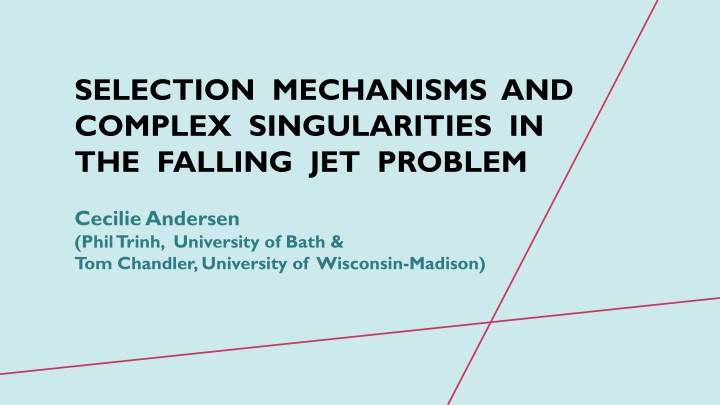
Insights into Falling Jet Mechanics and Complex Singularities
Explore the intricate selection mechanisms and complex singularities in the falling jet problem, discussing key parameters like the Froude number and Weber number. Dive into the problem formulation, potential planes, surface tension effects, selection mechanisms, and the role of ripples in this fascinating fluid dynamics study.
Download Presentation

Please find below an Image/Link to download the presentation.
The content on the website is provided AS IS for your information and personal use only. It may not be sold, licensed, or shared on other websites without obtaining consent from the author. If you encounter any issues during the download, it is possible that the publisher has removed the file from their server.
You are allowed to download the files provided on this website for personal or commercial use, subject to the condition that they are used lawfully. All files are the property of their respective owners.
The content on the website is provided AS IS for your information and personal use only. It may not be sold, licensed, or shared on other websites without obtaining consent from the author.
E N D
Presentation Transcript
SELECTION MECHANISMS AND COMPLEX SINGULARITIES IN THE FALLING JET PROBLEM Cecilie Andersen (Phil Trinh, University of Bath & Tom Chandler, University of Wisconsin-Madison)
MOTIVATION Consider a steady-state, gravity driven fluid that separates from a solid object. There are only three values the separation angle can take. ? < ? 2 ? = ? 2 ? > ? 2 ? ? ? ? =? ? =2? ? = ? 2 3 ? Key parameter: Froude number ? = ? 0 ? 2 ?
MOTIVATION ? ??2 ? ? Key parameter: Froude number ? = Weber number ? = ? (Surface tension parameter) Zero surface tension: ? = ? =? 2 ?1(?) ?3(?) ?2(?) ? ? 1 0 ? 2 ? There exist many open questions.
PROBLEM FORMULATION A two-dimensional, inviscid, incompressible fluid jet falls under gravity. Governing equations: ??? ?? 1 ?2 1 ?cos ? +1 ? ?? ??? ?? = 0 ? log? + ?? =1 ? ? ? (Hilbert transform) Variables: Key parameters: ? ?(?) speed Froude number ? = ? ?(?) angle ??2 ? ? = ? + ? ? potential 1 Weber number ? =
POTENTIAL PLANE A two-dimensional, inviscid, incompressible fluid jet falls under gravity. Governing equations: ??? ?? 1 ?2 1 ?cos ? +1 ? ?? ??? ?? = 0 ? log? + ?? =1 ? [?](?) Free surface lies on ? = ? > 0, ? = 0 Potential Plane ? = ? + ??
ZERO SURFACE TENSION Issue: Smoothly changing F, discontinuously changes ?.
SURFACE TENSION ??? ?? ?? 1 ?2 ?2 1 ?cos ? = 0 ??? 1 1 ?cos ? +1 ? ??? ?? = 0 ? ?? A range of separation angles, ?, are possible when surface tension is introduced. For given ? there exists a countable sequence of Froude numbers where ? = ?3? < ?2? < ?1 ? . ? 2, As surface tension decreases (? ) these Froude numbers tend to ? 1.
SELECTION MECHANISM ? = 8 ?3(?) ?2(?) ?1(?)
RIPPLES Ripples in solution are exponentially small in ? ?(?) = + ?? ? ?+ ?? ?
ANALYTIC CONTINUATION Consider a complex extension of the domain and find the analytic continuations of q and ? in the complex plane. ??? ?? 1 ?2 1 ?cos ? = 0 log? + ?? =1 ? [?](?) Idea: Singularities in the analytic continuation of the solution are key features required for an analytic theory of this problem.
A SINGULARITY Singularity approaches the origin (fluid separation point) as the Froude number approaches F 2 from above. ? +? 2 Free surface Wall
ANOTHER SINGULARITY Hypothesis: Singularity spirals towards the origin (fluid separation point) as the Froude number approaches F 1 from below. Free surface Wall ? ? 1
COMPLEXIFYING THE FROUDE NUMBER ??(?) QUESTIONS? 0 ? 1 ? 2 ??(?) ? Idea: Allow ? to be complex. Smoothly move around the regions with clustering singularities. Issue: Singularities cluster at origin for ? near ? 1 and ? 2. Numerics become difficult. Future work: Can we explore the region ? 1< ? < ? 2? Do the singularities for ? < ? 1relate to the singularities for ? > ? 2? Can this technique be used for other problems?
